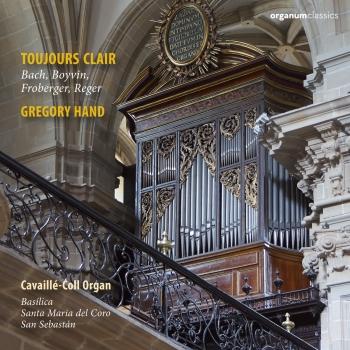
Toujours Clair Gregory Hand
Album info
Album-Release:
2022
HRA-Release:
08.09.2022
Label: Organum Classics
Genre: Classical
Subgenre: Instrumental
Artist: Gregory Hand
Composer: Johann Sebastian Bach (1685–1750), Johann Jakob Froberger (1616-1667), Max Reger (1873-1916), Jacques Boyvin (1649-1706)
Album including Album cover Booklet (PDF)
- Johann Sebastian Bach (1685 - 1750):
- 1 J.S.Bach: Praeludium Es-Dur: Prelude in E flat major BWV 552, 1 11:50
- Johann Jacob Froberger (1616 - 1667):
- 2 Froberger: Partita VI. Auff die Maÿerin FbWV 606 10:05
- Max Reger (1873 - 1916):
- 3 Reger: Toccata e-Moll: Toccata in E minor op. 65 Nr. 11 aus Zwölf Stücke 06:40
- 4 Reger: Fuge e-Moll: Fugue in E minor op. 65 Nr. 12 aus Zwölf Stücke 09:04
- Jacques Boyvin (1649 - 1706)
- 5 Boyvin: Suite de Quatriesme Ton from Livre d'Orgue I 16:27
- Johann Sebastian Bach:
- 6 J.S.Bach: Fuge Es-Dur: Fugue in E flat major BWV 552, 2 09:03
Info for Toujours Clair
Modern audiences sometimes associate musicmaking from the Romantic era with extreme rubato, impetuousness of spirit, and a calculated disregard for the fidelity of the text. Although this certainly existed, these characteristics were by no means universally employed. In fact, many Romantic musicians strove to achieve clarity in their performances. “Toujours clair, I have heard him (Guilmant) exclaim a hundred times …” his student Charles Galloway reported in The Etude magazine in January 1921.
The goal of this recording is to recreate the traditions of late Romantic organ performance, especially the traditions associated with Alexandre Guilmant, Charles-Marie Widor, Albert Schweitzer, and Karl Straube. These organists were some of the first to routinely include early music in their concert programs, and in some cases, they were the first to play pieces that had lain dormant for centuries. As such, they had no choice but to create a new performance practice tradition, which they described in detail in their work as editors of early organ music.
Besides this completely different approach to phrase and meter, there is considerable evidence that some tempos of the 19th-century, particularly in Baroque organ music, were considerably slower than those in the 20th- and 21st-centuries. What is immediately apparent from the evidence left by Alexandre Guilmant, Widor/Schweitzer, and Straube is that they were not firebrands or reactionaries. Instead, they viewed themselves as conservators of a tradition, and they worked tirelessly to uphold it. They prized order and rational thinking and chose to edit music of the past that reflected this order: Serious, well-composed music built on repetition of motives and phrases.
The Cavaillé-Coll organ in the Basílica Santa Maria del Coro in San Sebastián (Donostia), Basque Country, Spain
The organs of Aristide Cavaillé-Coll had won quick and almost universal acclaim after his stunning debut organ at the Basilique Saint-Denis in 1844. Much like Eberhard Friedrich Walcker in Germany, Cavaillé-Coll’s innovations in tonal and mechanical design changed the landscape of organ sound in Europe and inspired several generations of organists and composers to create masterworks for his instruments. But the Cavaillé-Coll organ was not just a vehicle for French symphonic music, it was considered a modern and versatile instrument that could render contrapuntal music of the past and present in a convincing way, and this included music written outside of France. There was, concurrent with the wave of new Cavaillé-Coll organs in France, a revival of interest in early organ music, and a new interest in German organ music.
Throughout some repairs and restorations, the organ in the Basílika Santa Maria del Coro in San Sebastián the was left remarkably intact. A balanced swell pedal was added and placed in the center of the console, which necessitated a re-ordering of the spoons for the appel anches and couplers.
This instrument is a testament to the glorious and poetic sounds of the French Romantic organ, the genius of Aristide Cavaillé-Coll, and the sheer artistry of his voicers. This recording documents the organ in its condition before the restoration planned for 2018.
Gregory Hand, organ
Gregory Hand
The American organist Gregory Hand is associate professor of organ at the University of Iowa. Prior to this appointment he held the position of University Chapel Organist at Northwestern University, where he also taught in the Music Theory department. He was awarded the Doctorate of Musical Arts degree from the University of Michigan, where he studied organ with James Kibbie and harpsichord with Edward Parmentier. Gregory Hand is in high demand as a performer and pedagogue. He was recently appointed to a five-year term on the jury of the Internatio nale Orgelwoche Nürnberg, and has given recitals and masterclasses in the United States, France, Spain, Germany and Brazil. He has served on juries for RYCO (USA), Mikael Tariverdiev and Nürnberg organ competitions. In 2012 he was the first organist to perform all twelve of William Bolcom’s Gospel Preludes, and later recorded these works on the Naxos label. He also has recorded a solo CD on the 2016 Klais organ in the Voxman Music Building of the University of Iowa’s School of Music on the Organ and Organum Classics label. As a harpsichordist he has appeared with Lyric Opera of Chicago, Chicago Opera Theater, and the Des Moines Symphony.
Booklet for Toujours Clair










